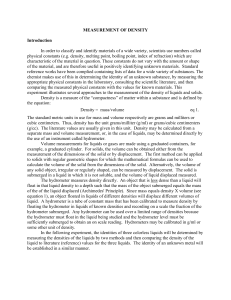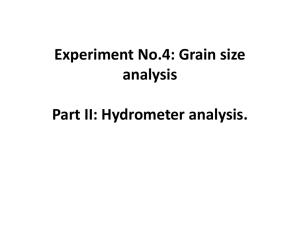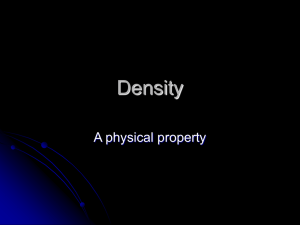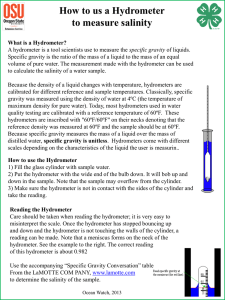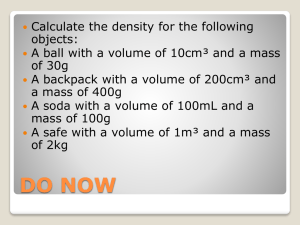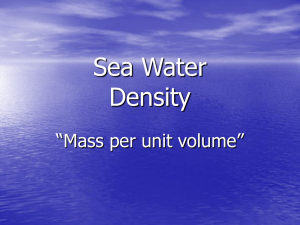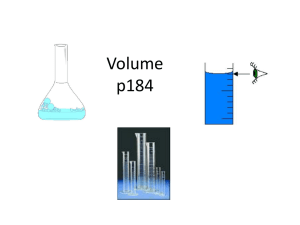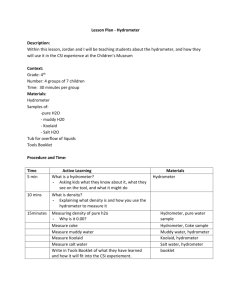MEASUREMENT OF DENSITY
advertisement
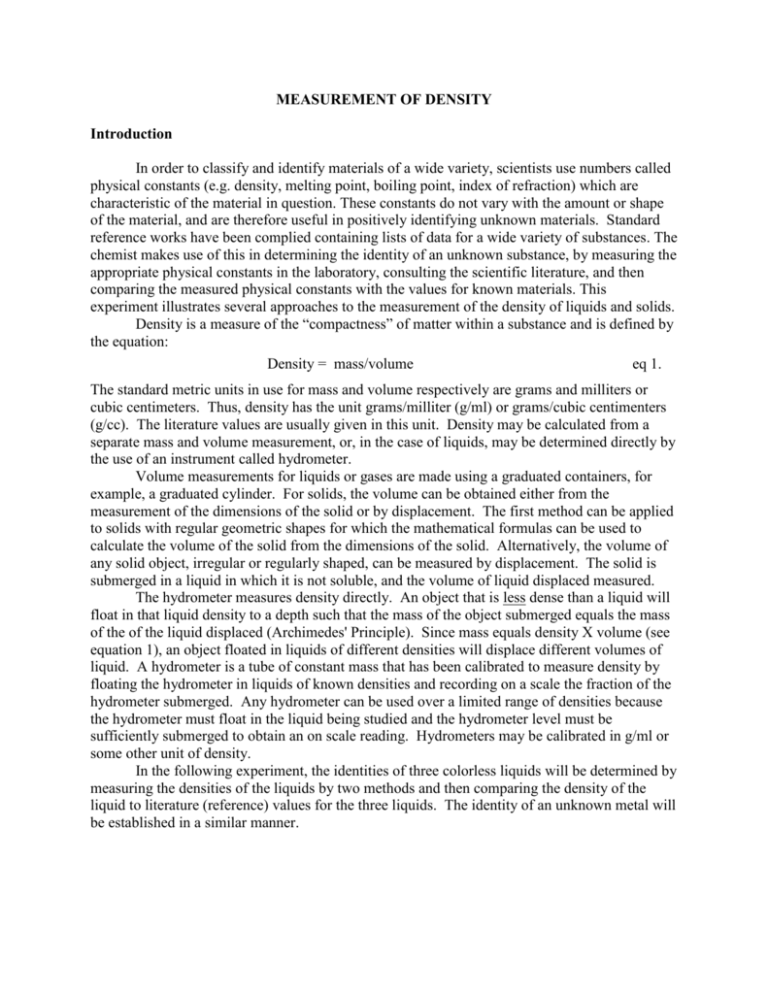
MEASUREMENT OF DENSITY Introduction In order to classify and identify materials of a wide variety, scientists use numbers called physical constants (e.g. density, melting point, boiling point, index of refraction) which are characteristic of the material in question. These constants do not vary with the amount or shape of the material, and are therefore useful in positively identifying unknown materials. Standard reference works have been complied containing lists of data for a wide variety of substances. The chemist makes use of this in determining the identity of an unknown substance, by measuring the appropriate physical constants in the laboratory, consulting the scientific literature, and then comparing the measured physical constants with the values for known materials. This experiment illustrates several approaches to the measurement of the density of liquids and solids. Density is a measure of the “compactness” of matter within a substance and is defined by the equation: Density = mass/volume eq 1. The standard metric units in use for mass and volume respectively are grams and milliters or cubic centimeters. Thus, density has the unit grams/milliter (g/ml) or grams/cubic centimenters (g/cc). The literature values are usually given in this unit. Density may be calculated from a separate mass and volume measurement, or, in the case of liquids, may be determined directly by the use of an instrument called hydrometer. Volume measurements for liquids or gases are made using a graduated containers, for example, a graduated cylinder. For solids, the volume can be obtained either from the measurement of the dimensions of the solid or by displacement. The first method can be applied to solids with regular geometric shapes for which the mathematical formulas can be used to calculate the volume of the solid from the dimensions of the solid. Alternatively, the volume of any solid object, irregular or regularly shaped, can be measured by displacement. The solid is submerged in a liquid in which it is not soluble, and the volume of liquid displaced measured. The hydrometer measures density directly. An object that is less dense than a liquid will float in that liquid density to a depth such that the mass of the object submerged equals the mass of the of the liquid displaced (Archimedes' Principle). Since mass equals density X volume (see equation 1), an object floated in liquids of different densities will displace different volumes of liquid. A hydrometer is a tube of constant mass that has been calibrated to measure density by floating the hydrometer in liquids of known densities and recording on a scale the fraction of the hydrometer submerged. Any hydrometer can be used over a limited range of densities because the hydrometer must float in the liquid being studied and the hydrometer level must be sufficiently submerged to obtain an on scale reading. Hydrometers may be calibrated in g/ml or some other unit of density. In the following experiment, the identities of three colorless liquids will be determined by measuring the densities of the liquids by two methods and then comparing the density of the liquid to literature (reference) values for the three liquids. The identity of an unknown metal will be established in a similar manner. Procedure 1) Weigh a clean, dry 50ml graduated cylinder. Add approximately 30ml of liquid to your weighed 50ml graduated cylinder without bothering to measuring out the liquid accurately. Now carefully read and record whatever amount of liquid there is in the cylinder. Weigh the cylinder and liquid, and then calculate the density of the liquid. Repeat this procedure to find the density of each liquid 2) Determine the density of each of the above, using a hydrometer and an ungraduated cylinder. Read the density from where the liquid crosses the hydrometer's scale. 3) Weigh and record the mass of an unknown metal cylinder. Also record the identity of the unknown metal cylinder (A, B, C, or D). Calculate the volume of the metal cylinder by measuring (in cm) the height (h) and diameter (d) of the metal cylinder and then applying the formula: Volume (cc) = = h x 0.785d2. Also, measure the volume of the metal cylinder by displacement of water in a 50ml graduated cylinder. Calculate the density of the metal cylinder for each method of measuring volume and identify the metal by comparing the value obtained with the literature values for various metals. 4) Using any appropriate procedure learned above, find the density of one of the following more objects: a coin, a piece of chalk, a small cork., Formulas for volumes of regular shaped objects Area of circle ¼ d2, where d = diameter, and = 3.14159 Volume of a cylinder = area of base x height Volume of a sphere 1/6 d3 Data and Calulations Name___________________ Date_________________Lab section________ a) Weight of graduated cylinder_______________g Liquid A Liquid B Liquid C Wt.of cyl + liquid ________g _________g _________g Wt. of liquid ________g _________g _________g Volume of liquid ________ml _________ml _________ml Density _________g/ml _________g/ml _________g/ml _________g/ml _________g/ml _________g/ml _________g/ml _________g/ml __________g/ml b) Density as determined with hydrometer: Literature value: c) Data for metal cylinder unknown No._________________ unknown color________________ weight _____________________g height ____________________cm diameter __________________cm volume(a)_________________cc (by calculation) volume(b)_________________ml (by displacement, 1 ml = 1 cc) density(a)_________________(b) _____________g/cc(g/ml) identity of metal_______________ literature value of density___________ literature source__________________ Density for special materials 1) Identity and description of material: Mass of material ________________ Volume of material ________________ Density of material ________________ 2) Identity and description of material: Mass of material ________________ Volume of material ________________ Density of material ________________ 3) Identity and description of material: Mass of material ________________ Volume of material ________________ Density of material ________________ Questions 1) Why is density a physical property useful for identifying an unknown substance? 2) As the density of a given liquid increases, will the hydrometer used to determine it float higher or lower in the liquid? Explain. 3) If a hydrometer touches bottom in a liquid, is its range too high or low for the liquid? Why? 4) a. Calculate the volume of 42.0g of tin (density 7.29g/ml)? b. Calculate the mass of 48 ml of lead (density 11.34g/ml)? 5) Calculate the density of 25.0ml of concentrated hydrochloric acid weighs 34.25g. 6) Indicate the density reading for each of the following hydrometers (shown by the position for the arrows). Give the correct number of digits and units. Figure 1—Hydrometers for question 6.
